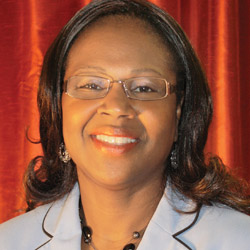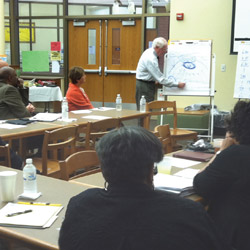Investing in District-Wide Change

When it comes to change, Peoria Public Schools is navigating the ebb and flow of many factors to achieve two results: improve student achievement and close the achievement gap, so that every student is highly prepared for post-secondary education or the workplace. Having academic clarity is just one piece of raising student achievement. We must also be committed to providing students and schools with the necessary resources. That means we must prepare a balanced and, equally important, stable budget.
Over the past year, Peoria Public Schools has made some progress regarding its fiscal and operational stability, but we still have a long way to go. One telling example is that of our district’s $170 million budget, we expect to lose 10 percent of government funding for the upcoming school year. By carefully and quickly reacting to changes like this reduction in state and federal aid, we can better support the academic future of our children.
 Before addressing the academic changes taking place, let’s take a look at the data that Peoria Public Schools will use in August to measure our progress. Although the Illinois Standards Achievement Test (ISAT) is just one indicator of student achievement, it’s the indicator with the most public scrutiny. Overall, 67 percent of our students are meeting or exceeding standards in reading, and 74 percent of our students are meeting or exceeding standards in mathematics. Our graduation rate is 90 percent. These numbers must improve.
Before addressing the academic changes taking place, let’s take a look at the data that Peoria Public Schools will use in August to measure our progress. Although the Illinois Standards Achievement Test (ISAT) is just one indicator of student achievement, it’s the indicator with the most public scrutiny. Overall, 67 percent of our students are meeting or exceeding standards in reading, and 74 percent of our students are meeting or exceeding standards in mathematics. Our graduation rate is 90 percent. These numbers must improve.
In 2008, then-candidate, now President Obama, shared some startling statistics; namely the following:
- China is graduating eight times as many engineers as America.
- By 12th grade, American children score lower on math and science tests than most other kids in the world.
- As a nation, we now have one of the highest high school dropout rates of any industrialized nation in the world.
With a major international company in our community and many others competing in an increasingly connected world, this school district must accept responsibility to do its part to prepare all students to compete. So, the goal is to move forward and move these numbers up so that by 2014, we increase to 79 percent of district students meeting or exceeding reading standards, 86 percent of our students meeting or exceeding mathematics standards, and 95 percent of our children graduating. We envision a future for Peoria Public Schools in which every student will be a reader, writer and mathematician, ready for college and work.
There are many changes taking place at Peoria Public Schools that are focused on the vision of providing our school district, families and community these results. We will deliver on this promise by focusing on key strategies to ensure success for our students:
 1. Students ready for kindergarten. Early childhood education can greatly increase cognitive abilities, leading to increases in achievement and school success. We must continue to advocate for significant improvements in early childhood education. We are centralizing the locations of our early childhood classes to realign resources and provide consistent professional development classes. Classes will be held at Valeska Hinton, Sterling and Manual High School for the 2011-12 school year.
1. Students ready for kindergarten. Early childhood education can greatly increase cognitive abilities, leading to increases in achievement and school success. We must continue to advocate for significant improvements in early childhood education. We are centralizing the locations of our early childhood classes to realign resources and provide consistent professional development classes. Classes will be held at Valeska Hinton, Sterling and Manual High School for the 2011-12 school year.
2. All 3rd graders reading on grade level. Seventy-one percent of our third graders are meeting ISAT reading standards. Research shows that children reading at grade level by the end of third grade has a direct correlation to subsequent academic success. Therefore, we have launched the “A Classroom is Calling” campaign. With the help of the CEO Roundtable and other community partners, we hope to provide a reading tutor for every third grader who is not on grade level when school opens in August. District 150 third-grade reading statistics will not be used to build prisons in Illinois, but rather colleges and corporations. Businesses and organizations are encouraged to go to our website, psd150.org, to sign up.
3. 8th graders ready for algebra concepts. In today’s ever-changing society, strong algebra skills are necessary for college and economic success. We want to prepare students for a rigorous math curriculum starting with providing algebra at 8th grade.
4. 9th graders ready for high school. The transition from middle to high school can be difficult for freshmen. We will align our middle school and high school curricula to ensure that our 9th graders will be successful. Rising 9th graders will have the opportunity to participate in a Summer Bridges program prior to the opening of school.
5. Students ready for college and work. We must have increased rigor throughout our high school curriculum. Research shows that the quality and intensity of high school curriculum is the single best predictor of college and work success. Therefore, the district will be focused on increased Advanced Placement enrollment and will seek to implement the rigorous International Baccalaureate Programme for Charter Oak Primary, Mark Bills Middle, Sterling Middle and Trewyn K-8, and expand the IB program at Richwoods.
6. The district will provide options for students to participate in career and technical opportunities. With the establishment of the Woodruff Career and Technical Center, high school students can receive training in construction trades (cabinet making, drywall, electrical, HVAC, plumbing) engineering (alternative energy, architecture and construction, manufacturing and materials, robotics) electrical (residential wiring), manufacturing (metals), and health science (dentistry, EMT, nursing, sports medicine, etc.).
Seven middle schools will also have a career and technical laboratory added to their schools for the 2011-12 school year (Calvin Coolidge, Lincoln, Trewyn, Mark Bills, Rolling Acres, Sterling and Von Steuben).
More than classrooms will be calling this coming year—add shop floors, laboratories and work sites to that list. Area companies, please consider investing in your future employees. We welcome your input and need your engagement.
7. Improve academic achievement at our high schools. To increase rigor and provide for a full academic schedule, we will provide a seven-period day for all students at Peoria and Richwoods high schools. Manual will continue to operate on a block schedule. We will focus on providing teachers the resources and training they need to teach from bell to bell.
In addition, we continue to build authentic relationships throughout the community. For example, in collaboration with Bradley University, our Full-Service Community Schools partner, the district launched a new Family Mobile Resource Center in late June. The Resource Center will travel to neighborhoods, primary schools and community events to:
- Distribute supplies
- Provide on-site nutrition classes
- Conduct mini-workshops
- Provide print and video material in partnership with several community agencies.
The mobile unit will also be used as an integral part of state-mandated “Child Find” events to identify children needing early intervention.
To complement our efforts, the school district will launch its Parent University, which will provide parent outreach and education for District 150 parents. Parent University classes will be held at Harrison Community Learning Center, Glen Oak Learning Center and Richwoods High School.
And as we talk about relationships, I must acknowledge that a key relationship of the district is with our labor associations. One interesting statistic is that nearly 85 percent of district employees are members of a union. Many of those associations have shown a willingness to accept and help create innovative programming. Just in the last couple of months, the teacher’s union agreed to a Memorandum of Understanding that will provide more flexibility for the operation of the new Woodruff Career and Technical Center and Trewyn K-8 School.
In addition, leadership from our unions, as well as parents, the community and administration, is represented in a newly revived Peoria Council for Continuous Improvement (PCCI). PCCI will focus on changes that impact Peoria High School through the School Improvement Grant, as well as systemic issues that impact the entire district. The council will identify areas where learning from the School Improvement Grant schools can be shared across the school system. PCCI will also help identify ways for the district to sustain changes beyond the term of the intervention. The Consortium for Educational Change will facilitate efforts to link the work of the PCCI with school Universal Leadership Teams to expand the learning across the system, beyond the schools targeted for intensive interventions.
Each of these items requires leadership and a measure of accountability. The comedian George Burns famously reminded us that no snowflake in an avalanche feels responsible or accountable. In contrast, I, the school board, and the general public demand accountability of this system and its employees. The measurement of progress—and holding ourselves accountable for the results—is critical.
This plan is ambitious. To follow through and succeed, the district needs family and community engagement. Peoria Public Schools will have a clear and strong academic focus, will align its fiscal and human resources to support the work in our classrooms, and will partner with families and the community to accelerate student success.
Help from the business community can also make a large impact! Here are just a few ways your business and/or employees can provide a helping hand in a successful future for our students:
- Be a mentor for 3rd grade readers.
- Support the development of a world-class career and technical education center.
- Donate to the Peoria Public Schools District 150 Foundation (ppsfoundation.org) and help implement innovative strategies in the classroom.
- Answer the phone when the school district calls.
In June of 1994, the Illinois Coalition for Public Education published 10 reasons to support public education. The No. 1 reason continues to resonate: Public education is a worthy investment for public funds. We can invest now, or we can pay later. iBi

